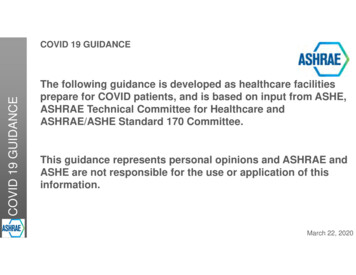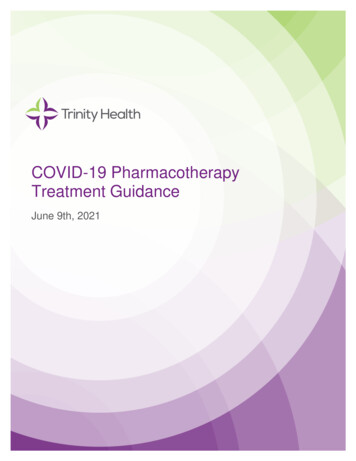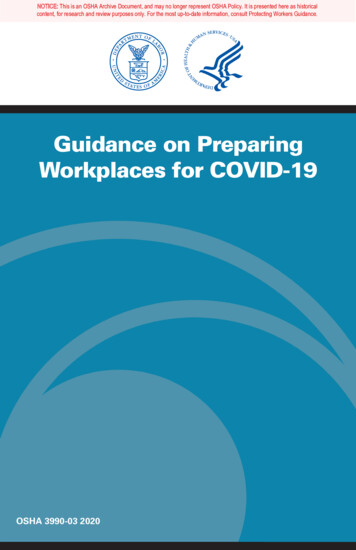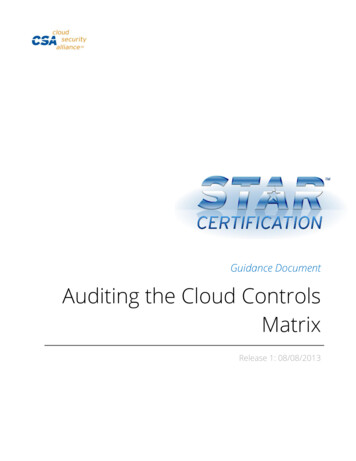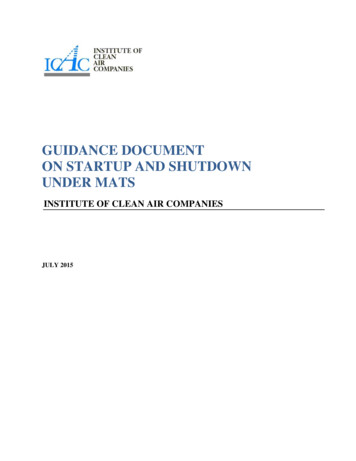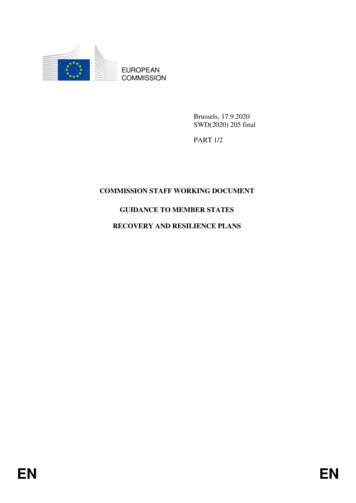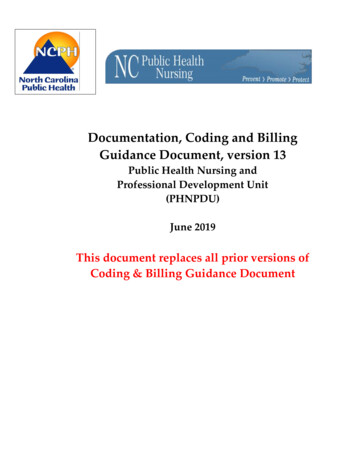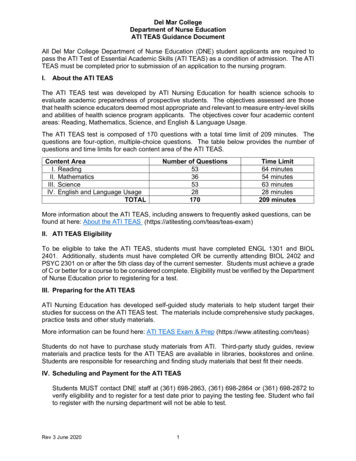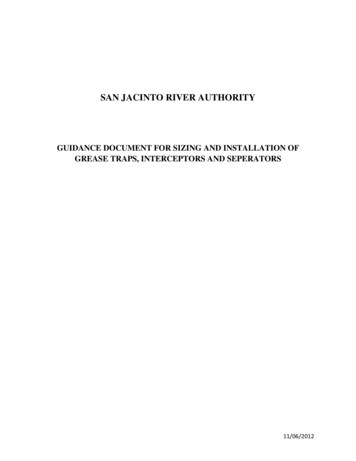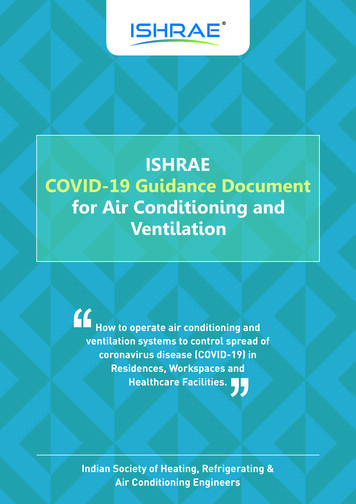
Transcription
ISHRAECOVID-19 Guidance Documentfor Air Conditioning andVentilationHow to operate air conditioning andventilation systems to control spread ofcoronavirus disease (COVID-19) inResidences, Workspaces andHealthcare Facilities.Indian Society of Heating, Refrigerating &Air Conditioning Engineers
ISHRAE COVID-19 Guidance Documentfor Air Conditioning and VentilationPrefaceOn 11th February 2020, the International Committee on Taxonomy of Viruses(ICTV) announced “severe acute respiratory syndrome coronavirus 2 (SARSCoV-2)” as the name of the virus that has caused the new disease COVID-19.A month later, the World Health Organisation made an assessment andannounced the disease to be a pandemic. COVID-19 has led to severe globalsocio-economic disruption impacting millions around the globe.India, with the rest of the world is facing the adverse effects of COVID-19.Concerns have been raised about the likelihood of the spread of the diseasethrough operation of Air-conditioning and Ventilation Systems. Infectiousdiseases can spread by several different routes including transmissionthrough air. The questions being asked are whether their spread can beaccelerated or controlled by heating, ventilating, air-conditioning andrefrigeration (HVACR) systems, depending on how the system is designedand operated.To put a comprehensive guideline together, a COVID-19 Task Force was setup by ISHRAE's Technical Committee. This Guideline has been preparedafter a detailed study and analysis of information and literature available tilldate.ISHRAE recommends that all facilities operated with air conditioningand ventilation, on the Indian Sub Continent, follow this guideline.Task force members :Mr. Barun AgarwalMr. Gautham BaligaMr. Jitendra M BhambureDr. Vishal GargDr. Jyotirmay MathurIn preparing this document , the COVID-19 Task Force has extracted,examined, analysed and compiled information pertaining to the Climaticregions of the Indian Sub Continent. The Team referred to publications inpeer reviewed journals and reports from other relevant organizations aroundthe world in arriving at this conclusive guideline.The COVID-19 Task Force comprises members from academia, designers,manufacturers , service providers and subject matter experts of relatedsciences such as Filtration, Healthcare Facility design, Indoor Air Quality,Safety, Thermal Comfort , System Design and Operation & MaintenanceI acknowledge the efforts of the Task Force members. This document isISHRAE's contribution to generate awareness, keep building occupants andservice providers safe and win over COVID-19.Mr. Richie MittalMr. Vikram MurthyMr. Shankar RajasekaranDr. Yash ShuklaMr. Amitabha SurVishal KapurChair – COVID 19 Task Force &ISHRAE Technical CommitteeFor any queries please write to covid@ishraehq.in1Release Date:April 13, 2020
ISHRAE COVID-19 Guidance Documentfor Air Conditioning and VentilationIntroductionThe COVID-19 pandemic, commonly known as CORONA has engulfed the world and India is no exception. TheCOVID-19 virus belongs to the CORONA family to which SARS and MERS also belong. As the COVID-19 virus isstill not fully understood, the behavior of SARS and MERS is considered as a reference to the extent they do notcontradict the present observations. The COVID-19 virus affects the respiratory track and starts with symptomssimilar to the common flu. This virus is a mutated strain and as of today no vaccine is available.The COVID-19 infection may result indeteriorating health or a patient's bodyimmunity may resist the infection, but stillremain a carrier. Close contact with those whoare infected and coughing or sneezing withoutmask protection can spread the infection. Thebest prevention as of today is ensuringisolation and distancing from an infectedperson. The difficult part is the carrier isasymptomatic in the incubation period varyingfrom 7 to 15 days. Most Governments havetherefore adopted distancing and isolation toavoid contact by locking down cities andcountries to different degrees.Figure 1 : Size of particle [1]COVID-19 Transmission RoutesThe size of a coronavirus particle is in the range of 80-160 nanometers. It is transferred via infected microscopicairborne particles and contaminated aerosol droplets. Droplets and small particles of a broad spectrum ofdiameters get generated during the course of coughing & sneezing and , to a lesser extent, even by talking andbreathing (refer Figure 2, which is indicative).Most large cough droplets fall on nearbysurfaces and objects – such as desks andtables, where they remain active for hours andeven 2-3 days. People can get infected bytouching those contaminated surfaces orobjects; and then touching their eyes, nose ormouth. If people are standing within 1-2meter of an infected person, they can beinfected by breathing-in droplets sneezed orcoughed out or exhaled by them.Figure 2- Particles emitted duringTalking, Coughing & Sneezing [2]2
ISHRAE COVID-19 Guidance Documentfor Air Conditioning and VentilationSmall particles (less than 5microns) released duringcough stay airborne forhours and can betransported over longdistances. Small dropletnuclei or residue are formedfrom droplets (usually withinmilliseconds) in the air, whichshrink in size due to theprocess of evaporation anddesiccation in low humidity.Figure 3- Infectious droplets shrink, travel far and evade surface cleaningwhen air is dry [3]It is known that most of the infectious particles ranging from 0.65 to 3.3μm in the cough-generated aerosolswere immediately respirable [4]. There is also no reported data or studies to rule out the possibility of theairborne-particle route. One indication for this: Corona virus SARS-CoV-2 has been isolated from swabs takenfrom exhaust vents in rooms occupied by infected patients.Apart from cough generated aerosols, the particulates suspended in the air also represents a substrate forviruses and consequently their transmission through this path [5]. In the indoor environment, one of the sourcesof dust is atmospheric dust (PM2.5 and PM10) coming in through fresh air intakes. The other prominent sourceis the dust generated by humans and processes. Reduction of indoor dust levels is a step towards mitigationof this source of COVID-19 transmission.The faecal transmission route for SARS-CoV-2 infections is implicitly recognized by WHO. It is known thatflushing toilets are creating plumes in the air containing droplets and droplet residue when toilets are flushedwith open lids. This makes it important that with the use of exhaust fans toilet air should not come into theother occupied areas. If toilet seats are equipped with lids it is recommended to flush the toilets with closed lidsin order to minimize the release of droplets and droplet residues from plumes in the air.Another path for transmission is when virus-laden aerosols are deposited on apparel and on the floor and thenget re-suspended into the air due to the movement of people. That is why sanitizing the floors frequently andlimiting the movement of people is helpful in curtailing this route of transmission. In healthcare facilitiessanitization of apparel is recommended as per protocol [6].Effect of Environmental Conditions1. RELATIVE HUMIDITYRelative humidity is found to affect the infectivity (the ease with which infection can take place) of virus throughthe respiratory route. The normal human body has excellent protection systems to prevent respiratoryinfections. There are several layers of filters starting with the mouth and the windpipe. The moist surfaces havingmucous layer collect the larger particles before they enter the trachea and pharynx in the upper respiratory tract.In the lower respiratory tract, the bronchi & alveoli can trap smaller particles to various degrees of efficiency.When we breathe dry air the mucous membrane in the lungs become dry. The fluid over lining the cells becomesmore viscous, and the little hairs called cilia, which protect our lungs from deep settling of viable & non-viableparticles, cannot work and particles settle more deeply in the lungs. If we consider oxygen & CO2 transport andthe blood, it is only one cell membrane that separates the airspace from the blood. So, if something goes fromour lungs into the blood, we get infected.3
ISHRAE COVID-19 Guidance Documentfor Air Conditioning and VentilationMoisture in the air is the first arm of our immune system and we now know that our body cannot fight off foreignparticles or invaders as adequately as when we're in a dry environment. Further, the infectivity of the bacteria tooincreases with low humidity. Relative humidity of at least 40% is considered the threshold [7]. Studies indicatethat 80% relative humidity and above tend to neutralize the COVID-19 virus. However, too much humidity leadsto higher levels of dust mites and fungi, two of the worst culprits for indoor allergy sufferers. Mold and fungi areknown to exacerbate respiratory conditions such as asthma.All things considered, the relative humidity level of 40% 70% is considered to be the most suitableenvironment for humans & decreases problems from pathogens.2. TEMPERATURETemperature tends to be a factor that directly affects the comfort of building or hospital occupants. Comforttemperature is generally considered between 24 - 30 C , after accounting for air velocity, relative humidity andclothing. The study of the transmission of COVID-19 virus in 100 cities of China indicates that high temperatureand high humidity significantly reduce the transmission of influenza [8].Studies conducted at various RH levels have shown that using viral culture methods low temperatures(7–8 C) were optimal for airborne influenza survival, with virus survival decreasing progressively atmoderate Temperatures (20.5–24 C) and further decreases at higher (greater than 30 C) temperatures[9].As per some recent studies, SARS-CoV-2 has been found highly stable on surfaces for 14 days at 4 C; oneday at 37 C and 30 minutes at 56 C were needed to inactivate the virus [10].Residential ApplicationsResidential spaces are cooled by Room Air conditioners, Evaporative Coolers and Fans.ŸRoom Air conditioners control temperature and reduce humidity.ŸEvaporative coolers are effective in Hot and Dry climates only. They reduce temperature by evaporatingwater .ŸFans provide body comfort by convection and evaporation due to increased air motion.ROOM AIR CONDITIONERSRoom air conditioners re-circulate air within a single occupied zone. Capacities vary from 1 to 3 TR (Tons ofRefrigeration). Installed for a single room application, the entry of occupants into such spaces is controllable.Recirculation of cool air by Room Air conditioners, must be accompanied by outdoor air intake through slightlyopen windows and exhaust by natural exfiltration.Fresh Air intake through a fan filter unit will prevent outdoor dust entry (containing high levels of PM 10 and PM2.5 particles) and exhaust through kitchen and toilet exhaust fans kept operational.Set Room Temperature between 24 C and 30 C. Maintain relative humidity between 40% and 70%. (In humidclimates set temperature closer to 24 C for de humidification and in dry climates closer to or at 30 C and usefans to increase air movement).In dry climates, do not allow Relative Humidity to fall below 40% . Water evaporating from a pan kept in the roomwill increase humidity if it falls below 40%.4
ISHRAE COVID-19 Guidance Documentfor Air Conditioning and VentilationEVAPORATIVE COOLERSEvaporative coolers, often known as desert coolers provide effective cooling in Hot and Dry Climates. A Fandraws hot and dry outdoor air over water-saturated pads, causing the water to evaporate and cool the Air. Airleaving the Evaporative Cooler, is up to 15 C cooler than outdoor air, is directed inward.Most evaporative coolers do not have air filters as original equipment, but they can be fitted to the cooler duringor after installation. This is advisable to prevent dust entry and maintain hygiene. Evaporative cooler tanks mustbe kept clean and disinfected and the water drained and refilled frequently.Horizontal-flow Evaporative Coolers installed in windows can effectively cool a room or a section of a room.Windows must be kept open to release humid air. Portable evaporative coolers that do not draw outdoor air arenot recommended, since their cooling reduces with humidity rising inside the space.Evaporative coolers must draw air from outside to ensure good ventilation.FANSFans, such as ceiling and Pedestal type, are an inexpensive yet effective method to provide indoor comfort. Theyincrease body comfort by increasing air motion to dissipate heat by convection and evaporation.Fans should be operated with windows kept partly open. If an exhaust fan is located at a nearby locationthen it must be kept running to exhaust air for better ventilation.Commercial and Industrial FacilitiesCommercial Establishments and Industrial Facilities have multiple occupancy as well as transient visitors. It is thisaspect that necessitates precaution in operating their Air conditioning Systems.For the purpose of Guidance for operation during a Pandemic like COVID-19 , Air Conditioning is Categorizedbased on the types of Indoor Units installed :(These indoor Units may be connected via refrigerant or chilled water pipes to DX Outdoor Units , VRF OutdoorUnits or a Chiller )The best action to limit risk of COVID-19 infection by air is to ventilate indoor environments with outdoor air asmuch as possible. Mechanical ventilation systems and air conditioning systems, which provide ventilation, canperform this function more effectively than simply opening the windows, because they improve the quality ofthe outdoor air with filtration.CATEGORIES OF INDOOR UNITS :i)Multiple Cassette Units: Ceiling mounted units that can each cool up to 50 sqm and can be controlledindividually or as a group.ii)Multiple Hi Wall Units: Used due to ease of installation and low Cost .iii) Tower Units: For larger spaces, where most occupa
To put a comprehensive guideline together, a COVID-19 Task Force was set up by ISHRAE's Technical Committee. This Guideline has been prepared after a detailed study and analysis of information and literature available till date. ISHRAE recommends that all facilities operated with air conditioning

